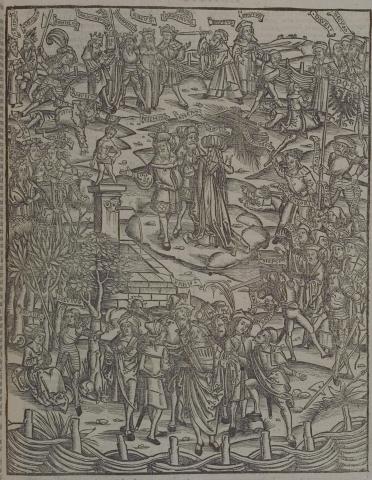Anchises, Aeneas and the Sibyl stand on a hill in the midst of the throng of shades waiting to pass back into the upper world (752-5). Anchises explains the future of Italy and Rome to Aeneas and the Sibyl, by indicating the shades who will become the important figures in Roman history (756-853). The catalogue of important figures starts in the lower left corner and winds clockwise. In the lower left corner, Lavinia, who will become Aeneas's wife, sits in a grove next to Silvius, who will be Aeneas's last son by her and king of Alba Longa (756-66). Above the grove are Procas, Capys, Numitor and Silvius Aeneas, kings of Alba Longa (767-70). Above Procas is his second son Amulius, not mentioned by Vergil; he has been slain, and the weapon wielded by Romulus, above him (777-80), looks ominous, but the figures are not directly related. In the top left corner stand Julius Caesar and Augustus (788-95). Standing to the right of Romulus are some of the other kings of Rome: Tarquinius Superbus, who holds a book that seems more appropriate for Numa to hold, Ancus Marcius, and Tarquinius Priscus; Numa is not included, though he is referenced by Vergil as the king who drafted the laws of the city (808-18). Brutus stands to their left, and points his sword at Tarquinius Priscus, though he actually killed Tarquinius Superbus (817-8). Brutus is shown again, killing his children who were planning to reinstate the Tarquins as rulers (820-3).
The Decii and the Drusi (824), two important Roman families, stand in the upper right corner. Below them, Camillus brings the standards back to Rome after saving Rome from the Gauls (825). Next to him, Manlius Torquatus (825), who was famous for slaying a Gaul, holds a cudgel; to his left is the fallen Gaul. Below them stands Cato the Censor (841), who famously wished for the destruction of Carthage; Cossus (841), standing next to him, killed the king of the Veii. The Scipiones (842-3) were distinguished warriors, while the Gracchi brothers (842) got themselves killed as tribunes of the plebs who tried to implement reforms unpopular with the senate. Mummius (836-7) destroyed Corinth. With these figures stands a man labelled Curius, who is probably Manius Curius Dentatus, Roman general who ended the Samnite war. He is depicted in place of Aemilius Paulus; Paulus is not named explicitly by Vergil, yet he is described as the man who defeated King Perseus in Macedonia (838-40). Below the crowd, Pompey and Julius Caesar are shown with their swords drawn (825-35). Rounding the corner to the left of the feuding rivals, Fabricius and Serranus (843-4), two famous generals, are depicted; they appear to be discussing something. To their left are a few Fabii, inlcuding Q. Fabius Maximus Cunctator (845-6), who defeated Hannibal by means of a series of delaying tactics. In front of Fabius are three unlabeled figures. It is tempting to think that one of them must be Marcellus (855-9). Another may be the unidentified figure attending him (860-6). It is perhaps a bit surprising that these figures aren't highlighted explicitly in this image, especially given the interest in his presence in the scene, but the absence of Marcellus is explained by the more elaborate illustration of Marcellus in the next image, "Exit from the Underworld".
Woodcut illustration from the “Strasbourg Vergil,” edited by Sebastian Brant: Publii Virgilii Maronis Opera cum quinque vulgatis commentariis expolitissimisque figuris atque imaginibus nuper per Sebastianum Brant superadditis (Strasbourg: Johannis Grieninger, 1502), fol. 282r, executed by an anonymous engraver under the direction of Brant.


Sebastian Brant (1458-1521) was a humanist scholar of many competencies. Trained in classics and law at the University of Basel, Brant later lectured in jurisprudence there and practiced law in his native city of Strasbourg. While his satirical poem Das Narrenschiff won him considerable standing as a writer, his role in the transmission of Virgil to the Renaissance was at least as important. In 1502 he and Strasbourg printer Johannes Grüninger produced a major edition of Virgil’s works, along with Donatus’ Life and the commentaries of Servius, Landino, and Calderini, with more than two hundred woodcut illustrations. (Annabel Patterson)